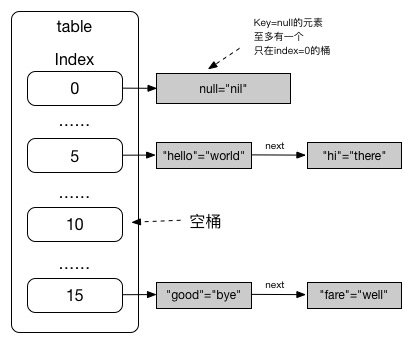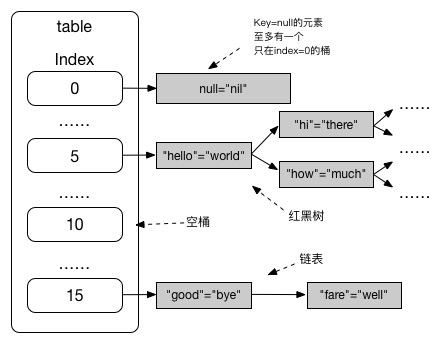HashMap 在 Java 编程中的出镜率相当高,是 Map 接口最常见的实现类。
这里涉及到一个基本的概念:
什么是 Hash? 直译为“哈希”,意译为“散列”,是根据 Hash 算法对某个对象的实例域进行序列化,产生一个整数,得到的序列化结果被称为哈希值,或散列码 (hash code)。
不同数据域的对象对应会产生不同的散列码。
给一个集合里面的所有对象计算散列码,我们称这个对象为散列表(hash table)。hashCode() 方法(该方法应与 equals() 兼容)。
Java 中的实现 在 Java 中,散列表使用链表数组 实现,数组中的每个链表被称为桶 (bucket)。
要想查找表中对象的位置,需要先计算散列码,与桶的总数取余,得到保存该元素的桶的索引。根据索引就可以得到对应的值。
有的时候会遇到桶被占用的情况,我们称之为散列冲突 (hash collision);此时需要将新对象与桶中的所有对象进行比较,查看是否已经存在了这个对象。头元素 加入桶中(头插法)。
若散列表太满,散列表需要再散列(rehash):创建一个桶更多的表,并将所有元素插入到新表中,再丢弃原来的表。负载因子 (load factor )决定何时对散列表进行再散列。比如将 load factor 设为 0.75(默认值),而表中超过 75% 位置已经填入了元素,那么在 rehash 的时候,会用双倍的桶数自动进行再散列。
如果散列码设计合理且随机分布,桶的数目足够大,比较次数就会减少。
如大致知道最终会有多少个元素要插入到散列表中,便可设置桶数,通常为预计元素个数的 75% - 150%。
HashMap 的实现 Map 接口继承自 AbstractMap,迭代时不保证元素顺序,线程不安全。
当散列冲突过于频繁的时候,HashMap 会退化为链表,或红黑树(Java 8+)。
Java 7 的 HashMap 实现 桶的实现:桶中的元素以链表 形式组织起来(数组+链表)。
元素类 HashMap.Entry 1 2 3 4 5 6 7 8 9 10 11 12 13 14 15 16 17 18 19 20 21 22 23 24 25 26 27 28 29 30 31 32 33 34 35 36 static class Entry <K ,V > implements Map .Entry <K ,V > final K key; V value; Entry<K,V> next; int hash; ... public final int hashCode () return Objects.hashCode(getKey()) ^ Objects.hashCode(getValue()); } public final boolean equals (Object o) if (!(o instanceof Map.Entry)) { return false ; } Map.Entry e = (Map.Entry) o; Object k1 = getKey(); Object k2 = e.getKey(); if (k1 == k2 || (k1 != null && k1.equals(k2))) { Object v1 = getValue(); Object v2 = e.getValue(); if (v1 == v2 || (v1 != null && v1.equals(v2))) { return true ; } } return false ; } }
常量及变量(数据结构) 1 2 3 4 5 6 7 8 9 10 11 12 13 14 15 16 17 18 19 20 21 22 23 24 25 26 27 28 29 static final int DEFAULT_INITIAL_CAPACITY = 1 << 4 ; static final int MAXIMUM_CAPACITY = 1 << 30 ;static final float DEFAULT_LOAD_FACTOR = 0.75f ;static final Entry<?,?>[] EMPTY_TABLE = {};transient Entry<K,V>[] table = (Entry<K,V>[]) EMPTY_TABLE;private transient Set<Map.Entry<K,V>> entrySet = null ;transient int size;int threshold;final float loadFactor;
关键方法 hash()
其实我们无需纠结于如何 hash,只需知道根据不同的 key 会将 entry 分配到不同或者相同的数组索引下,且分配均匀。
但是循例还是看一看代码:
1 2 3 4 5 6 final int hash (Object k) int h = 0 ; h ^= k.hashCode(); h ^= (h >>> 20 ) ^ (h >>> 12 ); return h ^ (h >>> 7 ) ^ (h >>> 4 ); }
indexFor()
根据散列值和数组长度计算数组索引,从而确定 Entry 将要,或者已经被放在哪一个桶:
1 2 3 static int indexFor (int h, int length) return h & (length-1 ); }
扩容 resize()
1 2 3 4 void resize (int newCapacity) ... threshold = (int ) Math.min(newCapacity * loadFactor, MAXIMUM_CAPACITY + 1 ); }
当新容量与负载因子的乘积(newCapacity * loadFactor)小于默认的最大容量时,新阈值 threshold 会变为这个乘积;否则变为默认的最大容量,并不再扩容。
addEntry()
1 2 3 4 5 6 7 8 9 10 11 12 13 14 15 void addEntry (int hash, K key, V value, int bucketIndex) if ((size >= threshold) && (null != table[bucketIndex])) { resize(2 * table.length); hash = (null != key) ? hash(key) : 0 ; bucketIndex = indexFor(hash, table.length); } createEntry(hash, key, value, bucketIndex); } void createEntry (int hash, K key, V value, int bucketIndex) Entry<K,V> e = table[bucketIndex]; table[bucketIndex] = new Entry<>(hash, key, value, e); size++; }
存放 put() 1 2 3 4 5 6 7 8 9 10 11 12 13 14 15 16 17 18 19 20 21 public V put (K key, V value) ... if (key == null ) return putForNullKey(value); int hash = hash(key); int i = indexFor(hash, table.length); for (Entry<K,V> e = table[i]; e != null ; e = e.next) { Object k; if (e.hash == hash && ((k = e.key) == key || key.equals(k))) { V oldValue = e.value; e.value = value; e.recordAccess(this ); return oldValue; } } ... addEntry(hash, key, value, i); return null ; }
获取 get() 1 2 3 4 5 6 7 8 9 10 11 12 13 14 15 16 17 18 19 20 21 22 23 24 25 26 27 28 29 final Entry<K,V> getEntry (Object key) if (size == 0 ) { return null ; } int hash = (key == null ) ? 0 : hash(key); for (Entry<K,V> e = table[indexFor(hash, table.length)]; e != null ; e = e.next) { Object k; if (e.hash == hash && ((k = e.key) == key || (key != null && key.equals(k))) ) return e; } return null ; } public V get (Object key) if (key == null ) return getForNullKey(); Entry<K,V> entry = getEntry(key); return null == entry ? null : entry.getValue(); }
Java 8 的 HashMap 实现 桶的实现:首先以链表形式组织;当元素数量超过阈值时,变成红黑树 的形式组织(数组+链表/红黑树)。
在当前版本,HashMap.Node 替代了原来的 Entry:
1 2 3 4 5 6 7 8 9 10 11 12 13 14 15 16 17 18 19 20 21 22 static class Node <K ,V > implements Map .Entry <K ,V > final int hash; final K key; V value; Node<K,V> next; public final int hashCode () return Objects.hashCode(key) ^ Objects.hashCode(value); } public final boolean equals (Object o) if (o == this ) return true ; if (o instanceof Map.Entry) { Map.Entry<?,?> e = (Map.Entry<?,?>)o; if (Objects.equals(key, e.getKey()) && Objects.equals(value, e.getValue())) return true ; } return false ; } }
与 7- 相似的是:
Node 直接实现了 Map.Entry,没有使用 AbstractMap 提供的对 Entry 的内部实现类;
一个 Node 的 key 值被设置之后不可变(final);
每个 Node 之间以单向链表的形式组织起来,前一个 Node 持有下一个 Node 的引用
hashCode() 计算方法 一致
Node 的 equals() 同样调用了 Objects 类的 equals(),分别比对当前对象和目标对象的 Key 和 Value
Objects 的 equals() 中,只有当两个对象均为 null 或 “==” 成立时才返回 true
常量及变量(数据结构) 1 2 3 4 5 6 7 8 9 10 11 12 13 14 15 16 17 transient Node<K,V>[] table; static final int TREEIFY_THRESHOLD = 8 ;static final int UNTREEIFY_THRESHOLD = 6 ;static final int MIN_TREEIFY_CAPACITY = 64 ;transient int modCount;...
关键方法 hash()
1 2 3 4 static final int hash (Object key) int h; return (key == null ) ? 0 : (h = key.hashCode()) ^ (h >>> 16 ); }
当 key 为 null 时返回 0;否则将 key 的 hashCode 与其 hashCode 无符号右移 16 位(忽略符号位,空位以 0 补齐)的结果进行按位异或运算。
存放 put() 与 Java 7 相比发生了很大变化:
1 2 3 public V put (K key, V value) return putVal(hash(key), key, value, false , true ); }
putVal()
1 2 3 4 5 6 7 8 9 10 11 12 13 14 15 16 17 18 19 20 21 22 23 24 25 26 27 28 29 30 31 32 33 34 35 36 37 38 39 40 41 42 43 44 45 46 47 48 49 50 51 52 53 54 55 56 57 58 59 60 61 62 63 64 65 66 67 68 69 70 71 72 73 final V putVal (int hash, K key, V value, boolean onlyIfAbsent, boolean evict) Node<K,V>[] tab; Node<K,V> p; int n, i; if ((tab = table) == null || (n = tab.length) == 0 ) n = (tab = resize()).length; if ((p = tab[i = (n - 1 ) & hash]) == null ) tab[i] = newNode(hash, key, value, null ); else { Node<K,V> e; K k; if (p.hash == hash && ((k = p.key) == key || (key != null && key.equals(k)))) e = p; else if (p instanceof TreeNode) e = ((TreeNode<K,V>) p).putTreeVal(this , tab, hash, key, value); else { for (int binCount = 0 ; ; ++binCount) { if ((e = p.next) == null ) { p.next = newNode(hash, key, value, null ); if (binCount >= TREEIFY_THRESHOLD - 1 ) treeifyBin(tab, hash); break ; } if (e.hash == hash && ((k = e.key) == key || (key != null && key.equals(k)))) break ; p = e; } } if (e != null ) { V oldValue = e.value; if (!onlyIfAbsent || oldValue == null ) e.value = value; afterNodeAccess(e); return oldValue; } } ++modCount; if (++size > threshold) resize(); ... return null ; }
可知当桶内元素达到一定值(8)时,桶中元素的数据结构从链表变为红黑树 。以下是树化的代码:
1 2 3 4 5 6 7 8 9 10 11 12 13 14 15 16 17 18 19 20 21 22 23 24 25 26 27 28 29 final void treeifyBin (Node<K, V>[] tab, int hash) int n, index; Node<K, V> e; if (tab == null || (n = tab.length) < MIN_TREEIFY_CAPACITY) resize(); else if ((e = tab[index = (n - 1 ) & hash]) != null ) { TreeNode<K, V> hd = null , tl = null ; do { TreeNode<K, V> p = replacementTreeNode(e, null ); if (tl == null ) hd = p; else { p.prev = tl; tl.next = p; } tl = p; } while ((e = e.next) != null ); if ((tab[index] = hd) != null ) hd.treeify(tab); } }
可知树化的条件有两个:
一个桶(链表形态)中的元素数量不小于 8
HashMap 中不少于 64 个桶(数组长度不小于 64)
需要两个条件约束的原因在于:因为如果桶数量过少,又发生了严重的 hash 冲突,则根本原因是因为桶的数量太少了 ,此时进行树化的意义不大,需要优先扩容(resize())。
获取 get() 实现相比 Java 7 的会复杂一些:
1 2 3 4 5 6 7 8 9 10 11 12 13 14 15 16 17 18 19 20 21 22 23 24 25 26 27 28 29 30 31 32 33 34 35 final Node<K,V> getNode (int hash, Object key) Node<K,V>[] tab; Node<K,V> first, e; int n; K k; if ((tab = table) != null && (n = tab.length) > 0 && (first = tab[(n - 1 ) & hash]) != null ) { if (first.hash == hash && ((k = first.key) == key || (key != null && key.equals(k)))) return first; if ((e = first.next) != null ) { if (first instanceof TreeNode) return ((TreeNode<K,V>)first).getTreeNode(hash, key); do { if (e.hash == hash && ((k = e.key) == key || (key != null && key.equals(k)))) return e; } while ((e = e.next) != null ); } } return null ; } public V get (Object key) Node<K,V> e; return (e = getNode(hash(key), key)) == null ? null : e.value; }
小结 不同 JDK 下对于 HashMap 的实现有以下不同之处:
JDK 1.7
JDK 1.8
存储结构
数组 + 链表
数组 + 链表 + 红黑树
初始化方式
单独函数:inflateTable()
直接集成到扩容函数 resize() 中
hash 值的计算方式
扰动处理 = 9 次扰动 = 4 次位运算 + 5 次异或运算
扰动处理 = 2 次扰动 = 1 次位运算 + 1 次异或运算
存放数据的规则
无冲突时,存放于数组;
无冲突时,存放于数组;
插入数据的规则
头插法(先将原位置数据后移一位,再将数据插入到该位置)
尾插法(直接插入到链表尾部/红黑树)
扩容后存储位置的计算方式
全部按照原来方法进行计算(hashChde ->> 扰动函数 ->> (h&length-1))
按照扩容后的规律计算(扩容后的位置 = 原位置 / (原位置 + 旧容量))
HashMap / ConcurrentHashMap v.s. Hashtable HashMap v.s. Hashtable 相近之处
HashMap 和 Hashtable 均实现了 Map 接口,元素存放都是无序的。
区别
Hashtable 继承自 Dictionary 类;而 HashMap 继承自 AbstractMap 抽象类
Hashtable 是线程安全的类,所有元素操作都是 synchronized 修饰的;HashMap 非线程安全
因此在执行单线程操作的时候 Hashtable 比 HashMap 慢
Hashtable 不可接受键或值为 null 的项;HashMap 可以接受 null 的键值对(key 和 value 为 null)
Hashtable 保留了 HashMap 已经去除的 contains() 方法
Hashtable 除了 HashMap 同样拥有的 Iterator 实现方式之外,还保留了 Enumeration 方式
HashMap 提供 keySet 视图的 fail-fast 遍历:当其他线程往 HashMap 增加或删除元素时,会抛出 ConcurrentModificationException
Hashtable 提供对 key 的 Enumeration 遍历:不支持 fail-fast
求 hashCode 的方法不同
1 2 3 4 5 6 7 8 9 public synchronized V put (K key, V value) if (value == null ) { throw ... } int hash = key.hashCode(); ... }
ConcurrentHashMap v.s. Hashtable 相同 :线程安全
不同
Hashtable 每次操作都会锁住整个表结构,导致每次只能有一个线程访问 Hashtable 对象;
ConcurrentHashMap 为 HashTable 的替代集合类。
HashMap v.s. TreeMap HashMap 在插入、删除和定位元素等操作占优;
而 TreeMap 在遍历有序的 key 集合时占优。

